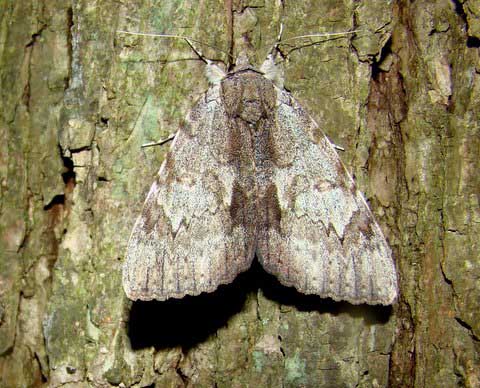Catocala insolabilis
Catocala insolabilis
kah-TOCK-uh-lahmmin-SOHL-ab-il-is
Guenee, 1852

Catocala insolabilis, Louisiana, courtesy of Vernon A. Brou.
This site has been created by
Bill Oehlke at oehlkew@islandtelecom.com
Comments, suggestions and/or additional information are welcomed by Bill.
| TAXONOMY:
Superfamily: Noctuoidea
Family: Noctuidae
Group: Noctuinina
Subfamily: Catocalinae
Genus: Catocala, Schrank, 1802
| |
MIDI MUSIC
"Moon River"
copyright C. Odenkirk
MIDI CITYON.OFF
<bgsound src="moon.mid" LOOP=FOREVER>
|
DISTRIBUTION:
The Inconsolable Underwing,
Catocala insolabilis
(wingspan: 65-75mm), flies from Ontario through
Maine and
Connecticut south
to Florida, west through
Arkansas to
Texas and Oklahoma and north to
South Dakota.
This species has also been reported in
Delaware,
District of Columbia,
Georgia,
Illinois,
Indiana,
Iowa,
Kansas,
Kentucky,
Louisiana,
Michigan,
Mississippi,
Missouri,
Nebraska,
New Jersey,
New York,
North Carolina,
Ohio,
Pennsylvania,
South Carolina,
Tennessee,
Virginia,
West Virginia and
Wisconsin.
The forewing is light grey with blackish shading along the inner
margin. The antemedial and postmedial lines are thin.
The
hindwing fringe is very narrow and grey, becoming whiter toward the
apex.
The ventral surface clearly distinguishes insolabis, being
almost completely black except for some white in the basal area.

Catocala insolabilis, Windsor, Ontario, coourtesy of Maurice Bottos.
FLIGHT TIMES AND PREFERRED FOOD PLANTS:
Catocala
insolabilis flies as a single
generation with moths on the wing from June to August.
The Catocala insolabilis caterpillar feeds on hickories.
ECLOSION:
Adults eclose from pupae formed under leaf litter.
SCENTING AND MATING:
Catocala insolabilis females
emit an airbourne pheromone and males use their antennae to track the
scent plume.
EGGS, CATERPILLARS, COCOONS, AND PUPAE:
Eggs are deposited on tree bark in the fall and hatch the following spring.
Mature larvae Image courtesy of |
 |
Larval Food Plants
Listed below are primary food plant(s) and alternate food plants.
It is hoped that this alphabetical listing followed by the common
name of the foodplant will prove useful. The list is not exhaustive,
although some species seem very host specific.
Experimenting with closely related foodplants is worthwhile.
This page is brought to you by Bill Oehlke and the
WLSS. Pages are on space rented from Bizland. If you would like to become a "Patron of the Sphingidae/Catocala Sites",
contact Bill.
Please send sightings/images to Bill. I will do my best to respond to requests for identification help.
Enjoy one of nature's wonderments: Live Saturniidae (Giant Silkmoth) cocoons.

|

To show appreciation for this site, click on the flashing
butterfly to the left, a link
to many worldwide insect sites. |
Return to Canadian Index
Return to Main Index



